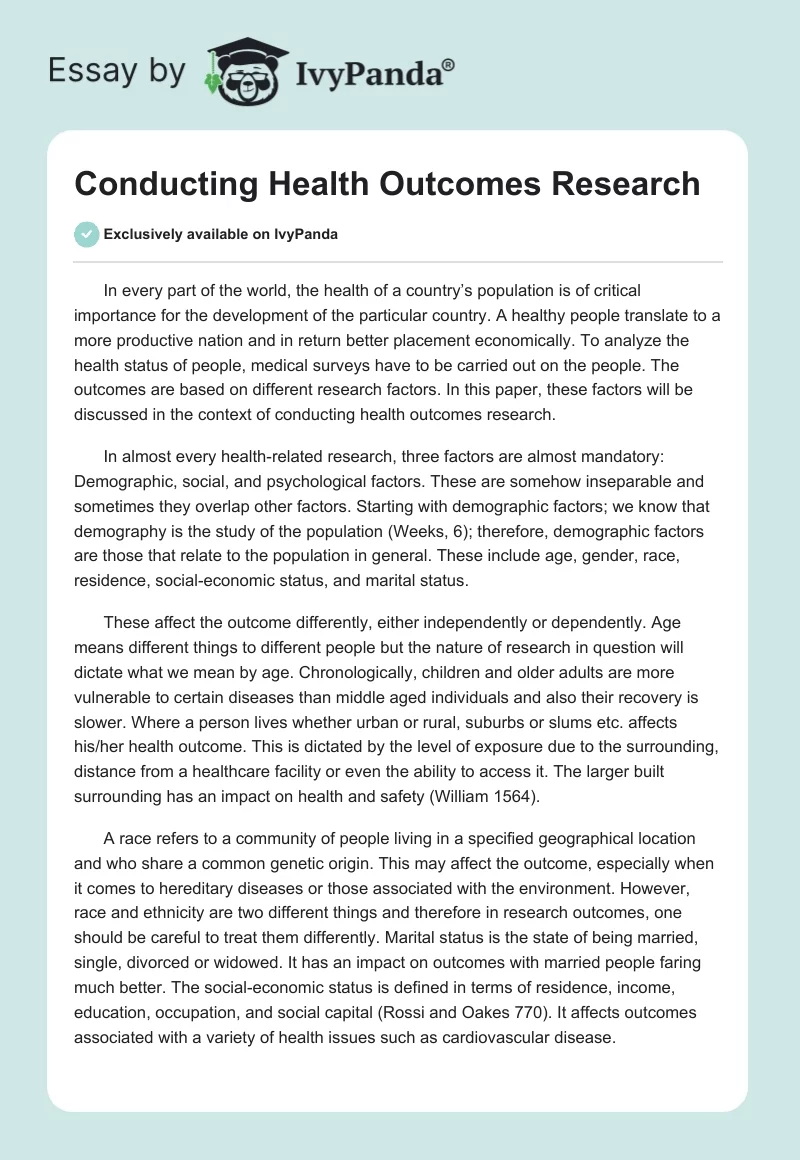In every part of the world, the health of a country’s population is of critical importance for the development of the particular country. A healthy people translate to a more productive nation and in return better placement economically. To analyze the health status of people, medical surveys have to be carried out on the people. The outcomes are based on different research factors. In this paper, these factors will be discussed in the context of conducting health outcomes research.
In almost every health-related research, three factors are almost mandatory: Demographic, social, and psychological factors. These are somehow inseparable and sometimes they overlap other factors. Starting with demographic factors; we know that demography is the study of the population (Weeks, 6); therefore, demographic factors are those that relate to the population in general. These include age, gender, race, residence, social-economic status, and marital status.
These affect the outcome differently, either independently or dependently. Age means different things to different people but the nature of research in question will dictate what we mean by age. Chronologically, children and older adults are more vulnerable to certain diseases than middle aged individuals and also their recovery is slower. Where a person lives whether urban or rural, suburbs or slums etc. affects his/her health outcome. This is dictated by the level of exposure due to the surrounding, distance from a healthcare facility or even the ability to access it. The larger built surrounding has an impact on health and safety (William 1564).
A race refers to a community of people living in a specified geographical location and who share a common genetic origin. This may affect the outcome, especially when it comes to hereditary diseases or those associated with the environment. However, race and ethnicity are two different things and therefore in research outcomes, one should be careful to treat them differently. Marital status is the state of being married, single, divorced or widowed. It has an impact on outcomes with married people faring much better. The social-economic status is defined in terms of residence, income, education, occupation, and social capital (Rossi and Oakes 770). It affects outcomes associated with a variety of health issues such as cardiovascular disease.
Secondly, we have psychological factors which define the mind-body connection. The effects of these are felt in particular areas of study. These factors include the general well-being which is measured as the general well-being schedule. Another thing is the locus of control which according to Rotter is an outgrowth of psychological work on proficiency and efficacy, but there are different conceptualizations of control among individuals and as a result different measures of control, (25).
Affect refers to states of the mind and body. Measures of effect should be sensitive enough to detect any change in these states (Lieberson, 98). Depression as observed by Shaver and Brennan is the commonest mental health disorder in the US, (14). Different instruments are available to aid with the study of the effect of depression among individuals.
Social factors are defined as the ability of individuals to do what is expected of them in a societal setting. These factors and their measures vary depending on the previous role of the case study in question. Often the measures may not be definite; the vagueness of these measures may require extra caution when choosing the right measure to use. It should be based on a particular aspect of that factor. The major outcome of social factors is how the individual fulfils his role.
Measures of social factors include social support which is further subdivided and includes different measurement instruments such as the social questionnaire (Sarason, Levine, Basham & Sarason, 130), a social function that analyzes the individual’s status and function (Remington & Tyrer 153) and other complex organizations such as commitment and work control (Dwyer and Ganster, 595). Also, Meyer and Allen brought about the idea of measuring individual commitment to his work (21).
This discussion may not be exhaustive as per the topic; however, the meanings and an overview of the factors involved in health outcome research have been covered.
Works Cited
Dwyer, Debra and Ganster Daniel. “The Effects of Job Demands and Control on Employee Attendance and Satisfaction.” Journal of Organizational Behavior 12,(1991): 595-608. Print.
Lieberson, Stanley. Making it count: The improvement of social research theory. Berkely, CA: University of California Press, 1985. Print.
Meyer, John P. and Natalie Jean Allen. Commitment in the Workplace.Thousand Oaks, CA: Sage Publications, 1997. Print.
Remington, Marina and Peter Tyrer. “The Social Functioning Schedule: A brief Semi-Structured Interview.” Social Psychiatry 14.3 (1979) 151-157, Print.
Rossi, Patrick and Oakes J. “The Measurement of SES in Health Research: Current Practices and Steps Toward a New Approach.” Social Science & Medicine. 56.4(2003): 769-784. Print.
Rotter, Julian. “Generalized Expectancies for Internal versus External Control of Reinforcement.”Psychological monographs: General and applied,80.1(1966): 1-28, Print.
Sarason, Irwin G., Henry M Levine, Robert B Basham and Barbara R Sarason. “Assessing Social Support: The Social Support Questionnaire.” Journal of Personality and Social Psychology 44.1(1983): 127-139. Print.
Shaver, Phillip and Brennan Kelly. “Measures of Depression and Loneliness”. In J.P Robinson J.P, Shaver, PR & Wrightsman L.S (Eds.), Measures of Personality and Social Psychological Attitudes. London: Academic Press, 1991. Print.
Weeks, John R. Population: An Introduction to Concepts and Issues (2nd Ed). Belmont: CA: Wadsworth Publishing Company, 1981. Print.
William, Lucy. “Mortality Risk associated with leaving home: Recognizing the relevance of the built environment.” American Journal of Public Health 93.9 (2003): 1564-1569. Print.


